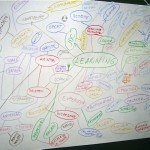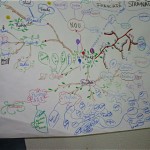I have spent much of the afternoon reading the UK Commission for Employment and Skills report on The role of career adaptability in skills supply. The report was written by my colleagues Jenny Bimrose, Alan Brown, Sally Anne Barnes and Deirdre Hughes from the Institute for Employment Research at Warwick University. It is particularly pertinent to our ongoing work on career transitions and Web2.0 and this post forms the first of two looking at some of the central ideas in the report.
Research in careers is limited yet careers choice and careers guidance are increasingly important with fast changing technologies and the world financial crisis rendering many occupations and jobs increasingly insecure. Few young people today will spend their entire working life in one occupation. The report based on empirical research undertaken in the UK and Norway looks at how people adapt to such a situation and how we can better support people through career transitions.
The term career adaptability, the authors say
describes the conscious and continuous exploration of both the self and the environment, where the eventual aim is to achieve synergy between the individual, their identity and an occupational environment. Developing career adaptability has a focus on supporting and encouraging individuals to be autonomous, by taking responsibility for their own career development. The operational definition of career adaptability used for this study was: ‘The capability of an individual to make a series of successful transitions where the labour market, organisation of work and underlying occupational and organisational knowledge bases may all be subject to considerable change’.
Central to the ideas of the report – and paqrazelling the development of Personal Learning Environments – is the aim of supporting autonomy and recognising that
‘career’ belongs to the individual, not to the employing organisation (Duarte, 2004).
The report identifies a set of five career adaptive competencies:
- control emphasises the need for individuals to exert a degree of influence on their situations;
- curiosity emphasises the value in broadening horizons by exploring social opportunities and possibilities;
- commitment stresses how individuals should experiment with new and different activities and projects, rather than being focused narrowly on getting into a particular job, so that new possibilities can be generated;
- confidence relates to believing in yourself and your ability to achieve what is necessary to achieve your career goal;
- concern refers to stimulating or developing a positive and optimistic attitude to the future. (Savickas et al., 2009, p.245).
Learning is obviously important in developing career adaptive competences, particularly learning through work.
The role of learning in developing career adaptability at work has four dimensions. The first involves learning through challenging work: mastering the practical, cognitive and communicative demands linked with particular work roles and work processes. The second has a primary cognitive focus and involves updating a substantive knowledge base (or mastering a new additional substantive knowledge base). Knowledge updating may play an important role in extending adaptability beyond a focus on the current work role. The third dimension has a primary communicative focus and comprises learning through (and beyond) interactions at work. Finally, the fourth dimension focuses upon how career adaptability is facilitated by individuals becoming more self-directed and self-reflexive in their learning and development.
One special aspect of being self-directed, illustrated by the quotes above, relates to being self-reflexive, able to identify your current skill set and how this might be enhanced and extended. Those who made successful transitions all seemed to be self-directed in either or both their learning and development and their career more generally. The link between being self-directed in your own learning and development and making successful transitions is transparent: if you can learn to adapt and continue to develop in your current job, even in less than ideal circumstances, then this provides a basis for making successful transitions in future. Several participants also pointed to the psychological dimension of how being self-directed and successful in making a major transition reinforced your confidence that you would be able to do this again in future, if required.
Those individuals who see that their skills can be transferred to other contexts have significant advantages in changing career direction over those who define themselves almost exclusively by their occupational and organisational attachments (Bimrose et al., 2008). This advantage stems from the former having a dynamic sense of themselves as being able to navigate their own route through the labour market, whereas the latter are dependent upon the pathways linked to a particular organisation or occupation.
However, the research based on a psychological-social approach, also recognised the importance of opportunity in careers transitions and the multiple-disadvantages many face in the labour market, especially in the UK, as opposed to Norway where class plays a lesser role. It also recognises the role that different labour market and education structures (and regulation) can play with regard to opportunity.
The term ‘opportunity structures’ itself contains the tension between openness and flexibility on the one hand and structured pathways on the other. Both are valuable and it is finding an accommodation which works well for most members of a society and also provides opportunities for those who do not fit initially. This should be the goal of a Continuing Vocational Training policy, informed by concerns for individual career developmen
The research approach was particularly interesting. In the EU funded G8WAY project we have been looking at the potential of storytelling, both as a research methodology or tool., and for helping young people reflect on education transitions. The career adaptability study also adopted a story telling approach.
The research study reported here adopted a retrospective and reflective approach – asking adults to reflect on their experiences of labour market transition, comment on the strategies they deployed and what, with the benefit of hindsight, they might have done differently. This approach has analytical power in that it enables individuals to ‘tell their career stories’, who invariably respond well to being given an opportunity to do so. Most individuals in our sample constructed coherent career narratives that had a current value in offering perspectives on where they were now, had been, and were going in their work lives. It could be argued that the career stories of some individuals may have been partly based on past events that have been reinterpreted from how they felt at the time they occurred. However, this misses an essential point about career adaptability: it is how the past is interpreted and reinterpreted which can act as a trigger to positive engagement with education and training when faced with labour market transitions. Hence, it is the stories in which we are interested, rather than searching for an unobtainable ‘truth’ about their attitudes and behaviours in the past.
This reflective approach has provided deep insights into dominant features that characterise an individual’s career adaptability profile, namely: individual (personality) characteristics; context and opportunities (opportunity structures); learning and development; and career orientation. These features are in constant and dynamic interaction, one with another.
One final aspect of being self-directed surfaced in many of our participants’ replies – people can learn from their lives through the stories they tell about them. Many of our participants recounted powerful narratives of where they had been, where they were and where they might be going. They were in charge of their own stories and such a perspective itself is an important component of adaptability.






